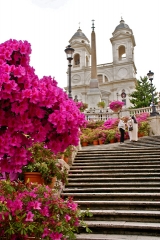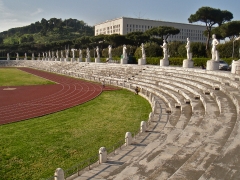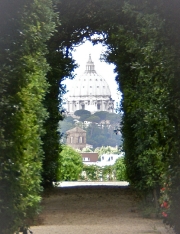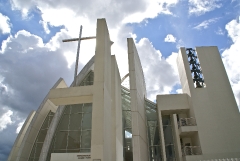
ROME – Walked up a hill to see the most famous – and most infamous – of all tennis players. That would be the great painter Caravaggio, of course.
Oh, I know he’s been dead for 400 years, but you never know who you’ll run into while wandering along Rome’s skinny cobblestone streets. Caravaggio, whose straight name was Michelangelo Mensi, is hanging out on the museum walls of the Scuderie del Quirinale, where he grabs you with stark reality: from a bowl of fruit – you reach for a pear – to Goliath’s decapitated head. He, the conquering David, is a self-portrait and his last painting . More contrasts; the Annunciation sharing space with a prim lady cutting a man’s throat. Not to mention believable angels, seductive St. John the Baptists (no less than four versions) and a game of cards.
What more could you want from this frequenter of tennis courts. Hacker or champ? No sports writers left word.

One of the most influential talents in the history of art, Caravaggio had a brief career spanning a short fifteen years with most of his work being done within one amazing decade.
All right, we know he had splendid hands with a brush. But what of his passion for tennis? He played as he painted – fiercely – in a walled court. His game was an ancestor of today’s version, on view not far away as the Italian Open at Foro Italico spread before you every May. Ruling this year were two left-handed Spaniards, Rafael Nadal and Maria Jose Martinez Sanchez.
I’m sorry to tell you that Caravaggio was a very bad sport. He killed an opponent, “a very polite young man” named Ranunccio Tommasini with a sword after an argument over a bet of 10 scudi. Nobody knows why. Maybe a disputed point. Whatever, it was decidedly against the rules, and Caravaggio had to flee Rome, an exile, shortly after the killing in May of 1606, never to return. Glad he didn’t take his paintings with him.

Murder isn’t unknown in tennis. Vere Gould, an Irishman who lost the All Comers final of the 1879 Wimbledon, and his French wife killed a woman they had hoped to rob. Losing in a different kind of court, they were convicted in France, died in prison, he on ghastly Devil’s Island.
But spring in Rome is too captivating to dwell on homicide. My roomie, Aurelio, combines monitoring the tennis at the Italian Open and tirelessly tramping the town with cameras. Some day I imagine she’ll walk to Paris.
She took her pal, Rosita, to the Aventine Hill to see the rose gardens, the orange groves, Santa Sabina, the Basilica Sant Alessio al’Aventino and to peek through the world’s most fascinating keyhole. This tiny opening in the garden of the Knights of Malta makes keyhole-peeping worthwhile, revealing St. Peter’s dome framed by orange trees. It is one of her favorite hidden treasures in Rome.

The crowds at the Trevi Fountains are so dense that you couldn’t fall in if you tried. Remember that husband-chasing movie and its corny theme song, “Three Coins in a Fountain”? Don’t remind me, please.
Since the dedication of Richard Meier’s Jubilee Church, Dio Padre Misericordia in October of 2003, Aurelio has yearned to see it. Her six year wait was rewarded at last after an hour’s drive to the suburbs.

Commissioned by Pope John Paul II as one of fifty new churches to celebrate the Millennium in 2000, this building, in a working class neighborhood, surrounded by apartment blocks, is well worth the six mile trip east of Rome through grueling traffic.
The building dazzles in its simplicity and purity. Light is its most important element. It is filled with symbolism, for example, the three shells, for the third millennium and for the trinity. Among Richard Meier’s works is the Getty Museum in Los Angeles.

You have to eat, of course, and it isn’t hard to find marvelous grub at one of the innumerable small eateries anywhere. Since we were staying at Cavalieri Roma (formerly the Cavalieri Hilton), on Monte Mario, the city lay handsomely at our feet. But we usually chose a neighborhood ristorante, da Luciano, to be greeted by the jolly namesake. His daughter, Stephania, son-in-law Mauricio and waiter Antonio flit among the tables, but the magician is in the kitchen – Mama Elena, the boss’s wife.

Ah, such pasta. Cacio pepe is divine. She has the touch of a Caravaggio – but not the ill-mannered use of the cutlery.END
Leave a Reply